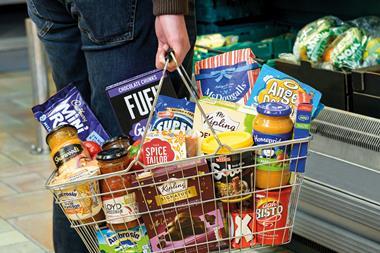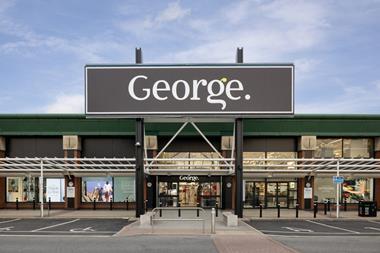analysis by Sarah Hardcastle
Could retailers be slowly killing off the proverbial "golden goose" of grocery namely the highly lucrative toiletries market in a bid to gain customers and market share? Certainly the signs point in this direction.
After years of substantial growth, the £3.5bn toiletries market, comprising haircare, skincare and male grooming, has slumped by 3.2% [Information Resources, 52 w/e September 10 2000].
What's dragged it down are high penetration commodity categories such as shampoo and deodorants, which have nosedived.
IR retail services director Charles Hamilton says the overall lacklustre performance is because of Every Day Low Pricing plus a significant lack of product innovation in the last 12 months.
"Toiletries has had more price deflation activity than any other category. Top selling lines in high penetration sectors have been particularly targetted which we can see in their value fall in relation to the more positive picture from the secondary sellers. At the same time there's been a fall off in product launches, which drive value growth."
Volume is also down in some sectors. "It says something about EDLP," says Hamilton. "It doesn't necessarily stimulate people to buy more. When you move from high:low promotions you take something out of the market. With EDLP, consumers know the price will remain the same so it doesn't encourage volume purchases."
Elida Fabergé hair category trade manager Sarah Crook is concerned by the volume as well as the value fall in haircare. "This is the first time we've seen a volume fall and we don't know why. Are consumers buying more designer and hairdresser brands, and from hairdressers?
"Are they turning to other channels, such as catalogues and Avon because they are dissatisfied with what is on supermarket shelves? We're investigating to find out why.
"What's very clear is that haircare has become promotionally driven and consumers have become so accustomed to the profusion of deep cut and buy one get one free' offers, their purchasing decisions are based on promotions rather than brand loyalty."
The other side of the picture is that these aggressive pricing strategies are achieving their objective of gaining market share for retailers. Asda health and beauty director Penny Coates says EDLP has boosted the multiples' toiletries share to 11% (September 2000) from 9.3% last year.
"Toiletries is a big focus for EDLP. We started with a few totem items with very deep cuts and are now rolling it out over the entire category over time. We try to maintain the price hierarchy, while offering the lowest prices. In areas we roll back, we're doing fewer promotions as consumers learn about EDLP, but when we do them we make them a lot stronger.
"Skincare is working particularly well because it has a lot of high priced products, so consumers see they are getting value for money. For example, Oil of Olay complete care fluid has come down from to £4.49 from £5.99 and Nivea Visage anti-wrinkle is £5.49 from £6.99. We don't do promotions in skincare where we have EDLP. The latest 12-week share value figures show we've overtaken Sainsbury in skincare and are now number two behind Tesco."
Safeway beautycare category manager Paula Dennison says the multiples' megadeals deep cuts on brands which have been running for a year, have increased its share of toiletries. "We're number two in terms of growth. Growth is at the expense of own label because promotions are making brands more accessible to consumers."
In haircare, an £885.2m sector [Information Resources], shampoo, hairspray and home perming kits are all declining, while the main growth is coming from new generation styling aids such as gels, creams and waxes, and hair colourants and lighteners areas with a high level of new product development.
Wella's ShockWaves is the leading brand in styling, providing the degrees of control required by today's short hairstyles. Trade marketing controller Mark Brill says the brand is growing 20% year on year, with an even split between male/ female usage and with a big youth audience. New variants were launched this summer in a range overhaul. "The youth hair market is constantly evolving, fickle and demanding," says Brill. Wella predicts that big, glamorous hair, requiring lots of styling maintenance, will be the next fashion.
Innovation has reinvigorated colourants, turning it from decline to growth. One of the most significant developments is Wella Viva Long Lasting Colour which comes with a colour remover enabling users to quickly revert back to their original shade. Brill says this feature has opened up a new market among first-time users and the adventurous wanting a short term change. Schwarzkopf says younger women are going for permanent colourants and is targeting them with its new Live Colors which comes in vibrant, fashionable shades.
Along with a number of manufacturers, Schwarzkopf sees huge potential in the burgeoning "grey" market, recently launching Re-Nature Creme, a re-pigmentation product for both sexes which is claimed to gradually return grey hair to its original colour. L'Oréal Paris is going for the same market with its new Grey Chic which enahances grey hair rather than covering it up, and comes in six shades.
Elida Fabergé is pursuing both "oldies" and colourants purchasers with its new Organics variants. Its Organics Vital shampoo and conditioner range aims to reduce the effects of ageing in hair, while Organics Color Activ' mousse claims to protect hair against colourant washout. Elida Fabergé's Crook says these products provide a big opportunity to generate value through trading up.
In personal wash, another area in which Elida Fabergé majors, category marketing manager Claire Collins says bodywashes with moisturisers, such as its Dove range, are the main growth area. "Consumers want a lot more now from shower products and love the pampering experience of two-in-one products like Dove," says Collins.
Another trend stretching across the whole market is the growth of products which include, or are based upon, natural ingredients. Safeway's new Nutri-therapy, a range of more than 40 face, body, hair, skin and children's products using herb, fruit and vegetable ingredients, is breaking fresh ground in own label toiletries.
Product manager Anita Lee says the ingredients route was chosen because it provides a link with Safeway's food heritage and ties in with the growing interest in herbal treatments. Prices are competitive £7.99 for anti-cellulite gel instead of £10 upwards for comparable products and as the range is solution driven it isn't cannibalising other toiletry sales, says Lee. Dual-sited in 150 stores, Lee says it is being rolled out to a further 40 outlets.
In skincare, worth £446.5m according to Information Resources, the main growth is coming from anti-wrinkle, anti-ageing and facial cleansing products, according to L'Oréal Paris category management director Caroline Bird. Under its leading Plénitude brand, the company has just launched the Age Perfect face cream range aimed at women over 60 who are now spending an increasing amount of time and money on personal grooming. A typical annual spend is £17.82, which is £2.37 more than the market average. Bird says this group, which has specific skincare needs, is becoming increasingly important as the older population grows in numbers.
In contrast, technology is driving facial cleansing growth with the creation of the convenient all in one eye and make up removal lotions and wipes, says Bird. L'Oréal has introduced Plénitude all-in-one lotion for face and eyes and will launch one for lips and eyes in January. Its new Hydrafresh cleansing gels are soap free products for 18 to 25 year olds.
Bird says a big issue in skincare is how to improve fixture presentation to make it easier to shop. "Our research shows consumers are confused by all the different products because there's limited common language between them and no significant segmentation. A solution which consumers would like to see is segmentation by key brands supported by product information rather than by product groups."
Asda is one of the first multiples to trial this concept, starting this month. "We'll let consumers decide which layout they prefer," says Asda's Coates.
The consensus is that male grooming is poised for growth, though Information Resources' figures show the £314m market in slight decline caused by EDLP and multibuys. Boots has recognised the significance of the sector, opening shops in Edinburgh and Bristol devoted to male grooming. And Elida Fabergé has just opened Lynx Barbershop in London's Oxford Street as an extension of its Lynx brand.
Driving growth is the upsurge in sales in deodorants, body sprays and shaving. In toiletries, Lynx and Gillette are the major brands, with Sara Lee's Brylcreem gaining share. The pace in shaving has been set by Gillette's hugely successful Mach3 razor and Wilkinson Sword's new Protector 3D Diamond, claimed as the ultimate in sharpness with safety.
{{FOCUS SPECIALS }}
Close menu
- Home
- Retail & Wholesale
-
Products & Suppliers
- Back to parent navigation item
- Products & Suppliers
-
Product Categories:
- Back to parent navigation item
- Product Categories:
- Alcoholic drinks
- Bakery
- Cereals & breakfast
- Cheese
- Chicken & poultry
- Chocolate
- Confectionery
- Crisps, nuts & snacks
- Dairy
- Fish
- Fresh produce
- Frozen
- Household
- Meat
- Own Label
- Sauces & condiments
- Seasonal
- Soft drinks
- Vaping
- Vegan & plant-based
- World foods
- Suppliers
- People
- Reports & Data
-
Topics A-Z
- Back to parent navigation item
- Topics A-Z
-
Popular topics:
- Back to parent navigation item
- Popular topics:
- Cost of living crisis
- Crime
- Deposit Return Schemes
- Finance
- Government & Regulation
- Health
- Inflation
- Loyalty
- Marketing
- Mergers & Acquisitions
- New Product Development
- Sourcing
- Supply chain
- Sustainability & environment
- Technology
- Ultra Processed Foods
- Vaping
- A-Z all topics
- Content by type:
- Events
- Ask iA (beta)
- Subscribe now
Sign in to comment on this article
Not logged in before? Register for FREE guest access today.
You will be able to:
- Read more stories
- Receive daily newsletters
- Comment on stories
Advert













No comments yet